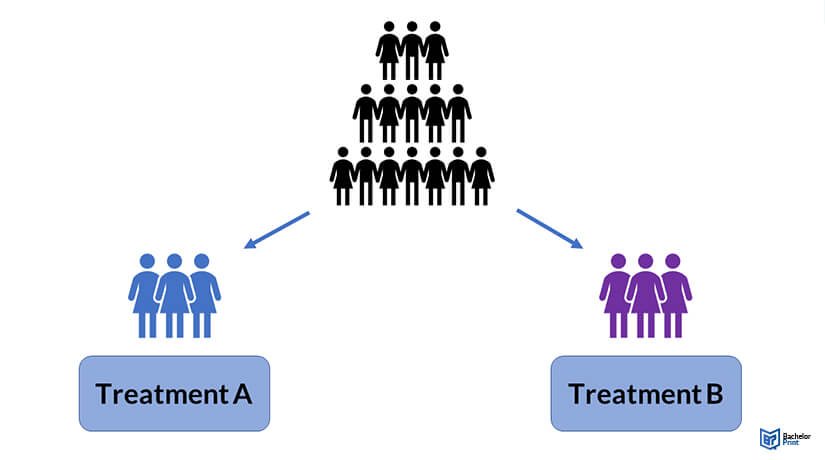
In experimental research, methodology is crucial to accurately gauge how an independent variable influences a subject under distinct treatments and conditions. One such methodology is the between-subjects design, where each participant is exposed to only one condition. This article delves deeper into the nuances and applications of a between-subjects design.
Definition: Between-subjects design
A between-subjects design, also referred to as a between-groups design is where each research participant is exposed to only one condition. Therefore, you can compare the differences between the participants in various conditions. The term “between” comes in because inferences are made by studying the differences between the participants in the different conditions.

Between-subjects design: How it works
For a between-subjects design to work, some requirements need to be met. For instance, there should be at least one experimental and control group. Alternatively, you can have numerous groups with a key differentiating variable, like ethnicity, sexuality, or gender identity.
Each experimental group in the research is assigned an independent variable treatment believed to impact the outcomes. On the other hand, the control groups are given a standard unrelated, fake, or no treatment, like a placebo.
Next, you compare the findings from the dependent variables between groups to determine if manipulation that was done on the independent variable was effective. If the resulting measures show a significant difference between the groups, you can deduce that the manipulation was responsible for the difference.
Using random assignment to group the participants is recommended to certify that the reference line subject qualities are analogous across the groups. You can also apply masking to ensure that the subjects will not work out if they are in the control or experiment group. Knowing the group they belong to will influence the responses and may result in various biases like social desirability or self-selection bias.
Next, apply a between-subjects design to split your sample into a control and experimental group:
Finally, you use statistical analysis to compare the percentage of positive reviews between the two groups.
Between-subjects design vs. Within-subjects design
A between-subjects design is the contrary of a within-subjects design. The term “between” implies that you will be likening the diverse environments between dissimilar groups. In contrast, the term “within” means that you will be likening the diverse circumstances within the same group.
Another vital difference between the two is that in a within-subjects design, each subject experiences all conditions. Therefore, the researcher tests the same subjects repeatedly to examine the variations between the conditions.
Another difference is that a within-subjects design does not feature control groups. Instead, subjects are verified beforehand and after the application of the independent variable treatments.
It is worth noting that within-subjects and between-subjects designs can be applied together in one study with more than one independent variables.
Researchers can use factorial designs to test multiple independent variables simultaneously. This experimental method combines individualized level of one independent variable with each of other independent variable to come up with varying conditions. In contrast, a mixed factorial design is where one variable is changed between subjects and extra within subjects.
You apply a similar experiment to all the participants in each group and compare the sleep hours at the end.
Between-subjects design: Pros and Cons
When choosing between a within-subjects or between-subjects design, you may benefit from looking at the pros and cons of each. Let us look at the upsides and drawbacks of a between-subjects design below.
Advantages of using a between-subjects design
A researcher would choose a between-subjects design over other experimental designs because there are less threats to inner validity. Other benefits of this experimental design are:
✓ Pros:
- It eliminates carryover effects from one experiment condition affecting subsequent conditions.
- It offers shorter study durations because you do not need to repeat the experiment over and over.
- It offers quicker and easier data collection.
Disadvantages of using a between-subjects design
The core downside of a between-subjects design is that it requires more resources for recruitment, session administration, and cover costs. This experimental design needs more subjects to match the statistical power of other designs.2 Other downsides of are:
✗ Cons:
- Validity may be threatened by individual differences
- It is more costly
FAQs
It offers a shorter study duration, prevents carryover effects, and reduces the risks of internal validity. However, it also requires a larger sample of participants and more resources, and personal differences may affect its validity.
It is a type of experimental technique where participants in a study are subjected to only one condition. The participants are either in a control or treatment group, or both.
In a between-subjects design, participants can only receive one condition depending on the group they are placed in. In contrast, a within-subjects design is where all participants experience all conditions.
It features a control and experimental group. The participants are split into the two groups where they only experience one condition. Afterwards, the researcher compares the results to determine if there is a difference.
